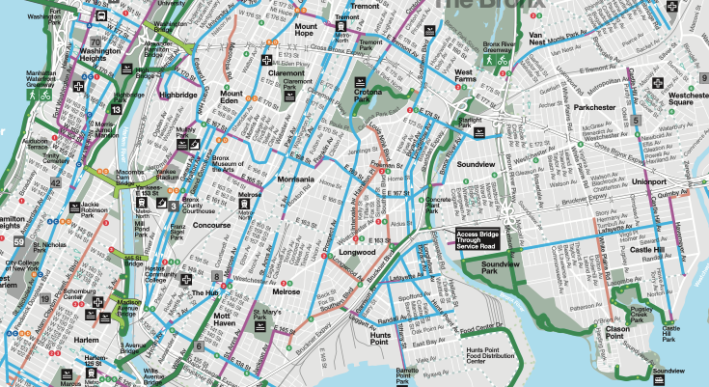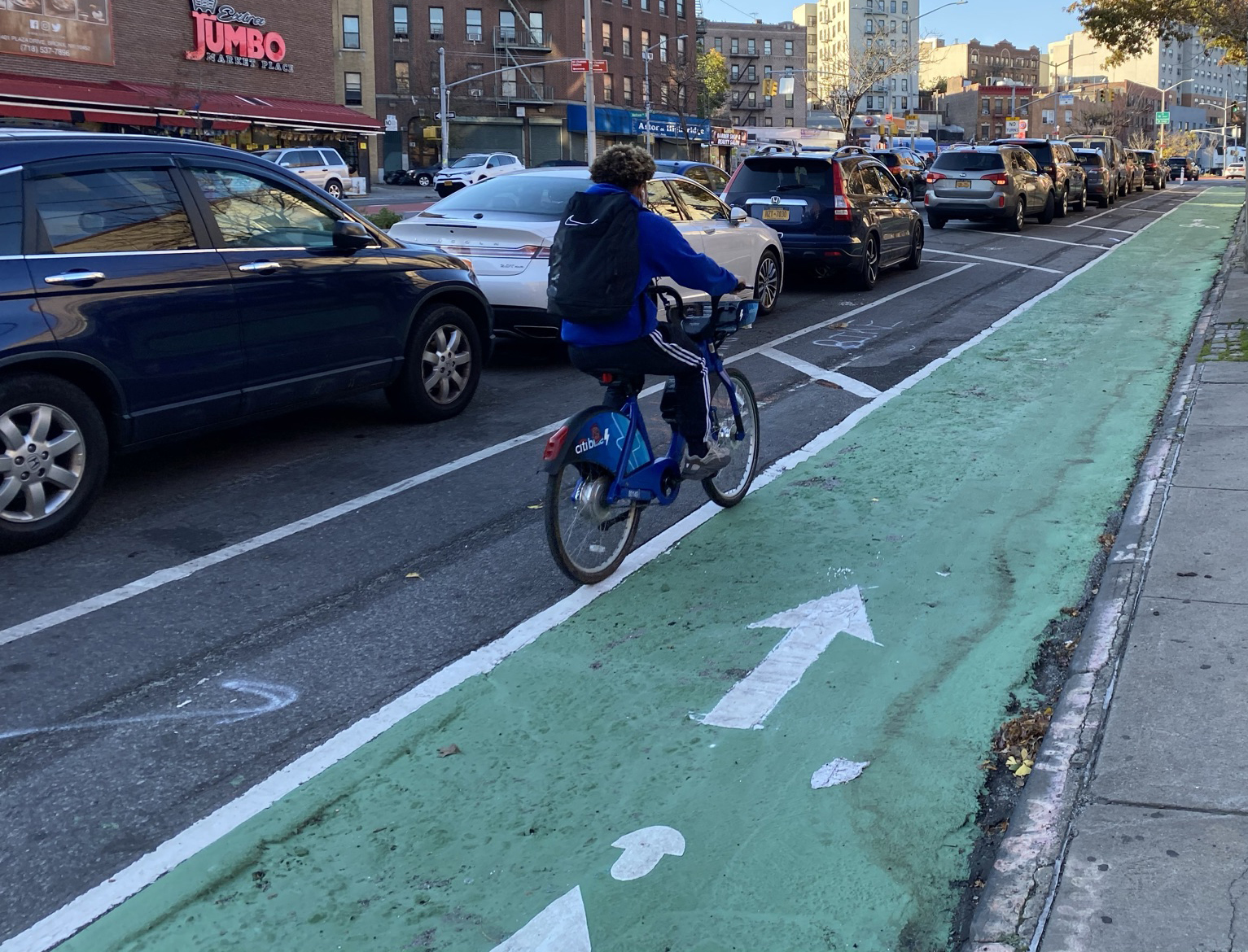
If you don't build it, they will come — and get hurt.
Injuries to Bronx cyclists are still soaring more than 45 percent compared to the same time period last year, even as total collisions and injuries to pedestrians are down, according to NYPD statistics — a likely casualty of the city expanding bike-share to the forgotten borough without also expanding protective bike infrastructure, pols and advocates say.
Since Citi Bike and the Department of Transportation unveiled the first docking stations in the Bronx in May — just as more New Yorkers took to cycling to avoid public transportation amid the COVID-19 pandemic — there have been 232,517 rides that started or ended in the borough, according to the Lyft-owned company. That's equivalent to roughly 38,750 rides per month, and about 1,290 each day.
But DOT did not match that growth with substantial additional protected bike lanes — a likely contributor to the rising number of people getting hurt, and even killed, while biking in the Bronx, according to a local pol. (The agency did just cut the ribbon on a protected bike lane on both sides of E.L. Grant Highway, adding 1.2 miles to the borough's limited infrastructure.)
“[Injuries stem from] the expansion of bike share — the Bronx is really lagging behind in protected bike lanes, the infrastructure is not there to safely ride a bike," said Bronx Council Member Andrew Cohen, a Transportation Committee member who represents a portion of the borough where there are still no Citi Bikes. "If you make bikes available to Bronxites, people are going to ride them. We need to provide the infrastructure to support it." (Point of information: There have been 1,726 reported crashes in Cohen's northwest Bronx district so far this year, injuring 51 cyclists, 112 pedestrians and 489 drivers, up from just 29 cyclist injuries over the same period last year.)
Dear @CitiBikeNYC,
— Welcome2TheBronx™ (@Welcome2theBX) May 7, 2020
It's nice to finally be able to say WELCOME TO THE #BRONX!
First Citi Bike 🚲 docking stations have been installed in The #southbronx and are LIVE!https://t.co/jnc51F0z9C
Citi Bike is clearly not the only reason people on bikes are getting hurt — injuries started rising as early as March and April, weeks before the company's expansion into the borough; and the cyclists that are getting killed are mostly on their own personal two-wheels, making deliveries.
Streetsblog first reported about the increase in April, when injuries to Bronx cyclists shot up to nearly 30 percent — a blood tide that continued through June, the summer, and now into the fall, when 696 riders have so far been injured this year compared to 482 over the same period last year.
The rise in injuries is a result of poor infrastructure. When the city announced it was installing nine miles of pop-up bike lanes to aid in the city's pandemic recovery, for example, none was in the Bronx, pointed out Erwin Figueroa, director of organizing at Transportation Alternatives.
“It’s not a unique problem because of the pandemic, it’s something that has been building to this point," he said. "There’s been an increase in cycling, including in the Bronx, but also the Bronx has not received the same amount of infrastructure. There were a number of announcements from the city highlighting where they were going to implement projects before COVID, and they never made an announcement coming for the Bronx."
Figueroa says that the Bronx has just 3 percent of the city's protected bike lane infrastructure, while Manhattan has more than 50 percent of it.
“The distribution of bike lane infrastructure is inequitable,” he said.

And a result, people are getting hurt — not just in the Bronx, but everywhere there are fewer protected bike lanes.
And the issue was only compounded by the scourge in speeding and reckless drivers on the road throughout the city's stay-at-home orders, according to another local pol. Streetsblog reported in April that cops were writing fewer speeding tickets, even as the city’s school-zone speed cameras caught more reckless drivers — the NYPD wrote 36-percent fewer tickets in March, compared to January, though the number of speed camera-issued tickets rose by 15 percent.
Bronx Council Member Fernando Cabrera, who also sits on the transportation committee, said his office has personally fielded more complaints about speeding in his district and blames reckless drivers for the uptick in bike injuries throughout the Bronx.
"We've seen a rise in people speeding — enough to be noticed by the community," said Cabrera, who wants the police to issue more tickets. "We need a bigger presence of the NYPD in terms of ticketing people driving faster."
But more than cops, Cabrera agrees with Figueroa that the borough needs more protected bike lanes, and especially ones that connect to other routes.
"The problem is not going to go away until we have more bike lanes where people feel safer in the Bronx," he said. "We have a bike lane, and then it stops and it's like, 'Wait a second, where do I go from here?'" said Cabrera, a cyclist himself. "I know we have a crisis in terms of our financial situation, but we have to put our constituents first — our lives first, our children, adults, people who for a living are riding all day." (Point of information: There have been 1,946 crashes in Cabrera's district so far this year (roughly six per day!), injuring 87 cyclists, 142 pedestrians and 683 drivers. That's up from 55 injured cyclists over the same period last year.)
Citywide, cyclist injuries are up 9.1 percent through Nov. 15, compared to this time last year; up 12.3 percent in Brooklyn North; 5.5 percent in Brooklyn South; 18.2 percent in Manhattan North; up 15.1 percent in Queens North; 9.5 percent in Queens South; and 28.8 percent in Staten Island. Injuries are down only in Manhattan South, by 27 percent, according to NYPD data.
In early September, after four cyclist fatalities over just three months, DOT Commissioner Polly Trottenberg — who last Monday announced her resignation — tried to stop the bloodshed by throwing more cops at the problem, instead of committing to providing the beleaguered borough with anything like a robust, protected bike-lane network.
The NYPD had previously conducted a four-week educational operation and ticket sting against reckless drivers, especially in high-crash corridors, but it did nothing to stop cyclists from getting hurt. Pedestrian injuries fell 80 percent — from 16 to 3 — during the police crackdown, but bike injuries didn’t budge, then-NYPD Chief of Transportation Nilda Hofmann said at the time.
And before the crackdown, the NYPD was writing far fewer tickets to reckless drivers. Comparing the first part of 2020 to the first part of 2019, the NYPD says it wrote 88,850 moving violation tickets from January through August, 2019, and just half of that — 44,417 — during the same eight months of 2020.
So far this year, 22 cyclists have been killed in the city — eight of them in the Bronx, according to DOT.






